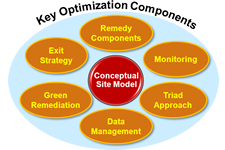Overview
Key Optimization Components
 The key components of optimization can be used to more effectively perform the activities necessary to demonstrate that a site meets cleanup criteria for protectiveness and ultimately site completion. The benefits of optimization may include improved remedy protectiveness; more cost-effective expenditure of Superfund dollars; lower energy use; reduced carbon footprint; improved project and site decision making; and acceleration of project and site completion.
The key components of optimization can be used to more effectively perform the activities necessary to demonstrate that a site meets cleanup criteria for protectiveness and ultimately site completion. The benefits of optimization may include improved remedy protectiveness; more cost-effective expenditure of Superfund dollars; lower energy use; reduced carbon footprint; improved project and site decision making; and acceleration of project and site completion.
CSM: A conceptual site model (CSM) is a representation of the interrelationships of key site information that directly supports project and site decision-making based on a comprehensive understanding of the uncertainty associated with the site information. A critical element of optimization at any project stage, the CSM requires review and update when new information is available. Learn more.
Remedy Components: During a remedy stage optimization evaluation, all aspects of remedy implementation and operation are evaluated in the context of remedial goals, technical performance and costs. In addition, optimization reviews focus on specific remedy components, equipment and processes, and their associated resource efficiency. From the assessment, potential issues and solutions are identified, as well as possible cost-saving alternatives. Learn more.
Monitoring: Monitoring is conducted after an active, passive or containment remedy has been selected and implemented, and is used to evaluate the degree to which the remedial measure achieves its objectives (such as the removal of soil or groundwater contaminants, restoration of groundwater quality). Learn more.
Triad Approach: The principles of the Triad Approach include systematic project planning (SPP), dynamic work strategies (DWS) and use of real-time measurement technologies. The goals of the Triad Approach are in alignment with optimization because Triad's goals also support ensuring protective and cost-effective remedial strategies. Learn more.
Data Management: Data management refers to the strategy and methods for collecting, processing, synthesizing and evaluating data. Learn more.
Green Remediation: The EPA's definition of Green Remediation is "The practice of considering all environmental effects of remedy implementation and incorporating options to minimize the environmental footprint of cleanup activities." Green Remediation is synonymous with efficiency, which is a core tenet of optimization. Learn more.
Exit Strategy: A site exit strategy is a formal plan for guiding a site from characterization through remediation to closure or reuse. An effectively designed exit strategy supports active decision-making throughout the remediation process to maximize the opportunities to optimize remediation and monitoring efforts. A comprehensive exit strategy addresses unique and interdependent issues at various levels (including organizational, programmatic, site- and stakeholder-specific, technical and administrative) to demonstrate that performance goals have been achieved, response objectives have been met and remedial activities can be terminated. Learn more.




